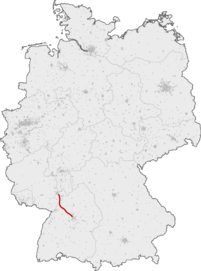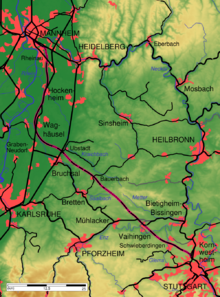- Mannheim–Stuttgart high-speed railway
-
Mannheim–Stuttgart high-speed railway Line length: 99 km (61.5 mi) Gauge: 1,435 mm (4 ft 8 1⁄2 in) Voltage: 15 kV, 16⅔ Hz AC Maximum incline: 0.125 % Minimum radius: 5,100 m (16,732 ft) Maximum speed: 250 km/h (155.3 mph) Stations and structures Legend
Ried Railway from Frankfurt 


Palatine Ludwig Railway from Ludwigshafen 


0.0 Mannheim Hbf 


Rhine Railway to Schwetzingen (see below) 


Mannheim Hbf Ost (junction) 


2.0 Container yard bridge (1100 m) 


Ried Railway to Frankfurt 


freight line from the Ried Railway 


freight line from the Rhine Railway 


Mannheim Rbf stop 


Mannheim marshalling yard 


5.1 Mannheim-Pfingstberg (crossover) 


5.6 Pfingstberg Tunnel (5380 m) 


Rhine Valley Railway to Heidelberg 


A 6 
Rhine Railway Mannheim–Schwetzingen 

11.5 Schwetzingen Brühler Weg (crossover) 
16.9 Schwetzingen crossing structure (126 m), A 6 
Speyer–Schwetzingen line, now siding 
A 61 


Rhine Railway from Schwetzingen (see above) 


20.9 Hockenheim 


Neulußheim 


(separation of the lines) 


27.7 Oberhausen (crossover) 


31.7 Waghäusel Saalbach (junction) 


connecting line to Graben-Neudorf 


Rhine Railway to Karlsruhe 
34.7 Waghäusel Lußhardt (crossover) 
35.0 B 36 Tunnel (65 m) 
40.5 Forst (crossover) 
40.7 Forst Tunnel (1726 m) 
A 5 


Rhine Valley Railway Karlsruhe–Heidelberg 


Katzbach Railway to Odenheim,
Kraich Valley Railway to Menzingen


45.3 Bruchsal Rollenberg (junction) 
45.2 Rollenberg Tunnel (3303 m) 
47.4 Bruchsal Eisenhut crossover 

49.1 Oberbruch Viaduct (220 m) 
50.1 Altenberg Tunnel (220 m) 
50.9 Neuenberg Tunnel (762 m) 
52.2 Frauenwald Viaduct (704 m) 
53.0 Simonsweingarten Tunnel (420 m) 
55.5 Maintenance base Kraichtal 
56.4 Bauerbach Viaduct (748 m), Kraichgau Railway 
59.2 Zigeunergraben Viaduct (660 m) 
60.4 Wilfenberg Tunnel (1006 m) 
62.1 Freudenstein Tunnel (6800 m) 
62.5 Freudenstein crossover 

69.5 Sternenfels Mettertal crossover 
71.7 Burgberg Tunnel (1115 m) 
73.2 Saubuckel Tunnel (403 m) 


Western Railway from Mühlacker (former route) 


former Vaihingen Stadtbahn 


78.5 Vaihingen (Enz) 


79.1 Markstein Tunnel (2782 m) 


Western Railway to Bietigheim-Bissingen 

82.0 Enz Valley Railway (1044 m) 
83.5 Vaihingen Enztal (crossover until 2010) 
84.2 Pulverdingen Tunnel (1878 m) 
87.8 Glemstal Viaduct (348 m) 
89.0 Markgröningen Glems crossover 
94.1 Langes Feld Tunnel (4632 m) 
A 81 
95.9 Kornwestheim marshalling yard (junction, not built) 
96.0 Stuttgart Langes Feld (Üst) 
97.9 Stuttgart-Zuffenhausen Em (junction) 


Langes Feld II Tunnel (677 m) 


98.1 End of Langes Feld Tunnel 


Schuster Railway to Stuttgart-Untertürkheim 


Franconia Railway from Bietigheim-Bissingen 


End of Langes Feld II Tunnel 


(End of new line) 

Black Forest Railway from Weil der Stadt 

98.8 Stuttgart-Zuffenhausen 

(see Franconia Railway) 

Stuttgart Hbf The Mannheim–Stuttgart high-speed railway is a 99 km long railway line in Germany, connecting the cities of Mannheim and Stuttgart. It was officially handed over for operations on 9 May 1991 and the first InterCityExpress ran on it on 2 June. The Hanover–Würzburg high-speed railway opened at the same time. It includes 15 tunnels and more than 90 bridges and cost about DM 4.5 billion to build.
Contents
Planning
Planning for a new line between Mannheim and Stuttgart (the two largest cities of Baden-Württemberg) began in 1970. The railway lines that it replaced followed the terrain and followed rivers and valleys, resulting in steep gradients and sharp curves and thus not suitable for high-speed trains. The 1973 federal transport plan incorporated the following minimum requirements for mixed traffic to accommodate heavy, slow goods trains and light fast passenger trains:
- maximum grade of 1.25% (occasionally 2.0%)
- curves with small superelevation and minimum radii of 4,800 m to 7,000 m
- maximum line speed of 250 to 300 km/h
- average construction costs of 30 to 50 millions DM per kilometer
- point-to-point connections between two railway junctions.
These requirements made necessary a large number of structure such as bridges and tunnels.
In addition new technology had to be applied: the Forst Tunnel is for its entire length under the water table and required a new dewatering technology. The Freudenstein Tunnel drives through gypskeuper, which flows as a result of heavy rains on the hillsides above it and required expensive safeguards, which were used for the first time.
In 1974 the first planning statement for the Mannheim-Stuttgart route was published. In 1975 the Federal Minister for Transport issued the building permit and construction began in 1976. More than 6,000 objections led to changes in the route when the line was already under construction. The building of some sections was occasionally completely stopped. In seven places the protests of the nearby resident led to the building of cut and cover tunnels. The longest tunnel of this kind was the Pfingstberg tunnel, which leads through a forest near Mannheim-Rheinau, which is a declared water protection zone.
The route has a (comparatively low) maximum gradient of 12.5 per thousand with curves having a normal radius of 7,000 m and a minimum radius of 5,100 m. Superelevation are limited to a maximum of 80 mm. The design speed for ICEs is 300 km/h and in places limited to 250 km/h. Crossovers were provided for the planned operations mixing passenger and goods trains and for maintenance operations every five to seven kilometres. Planning for the entire route was not resolved until 1985.
Construction
The first section was completed on 31 May 1987 between the junction with the Rhine Railway in Mannheim and Graben-Neudorf.[1] The last section to be completed was the second tube of the Freudenstein Tunnel, which was finished a few months before the opening of the whole line.[2] In 1991 the whole route was handed over to traffic.
Before the commencement of passenger operations two thousand training runs were undertaken to familiarise drivers with the technical characteristics of driving on high-speed lines, such as in-cab signalling and preventing the application of the emergency brakes.[3]
Operations
The Mannheim-Stuttgart line was handed over for commercial operations between on 9 May 1991 and the first ICE ran on it on 2 June. Initially the maximum speed was 250 km/h, with 280 km/h permitted to overcome delays.[3] Currently the maximum speed is about 250 km/h, whether or not there is a delay. The opening of the line reduced the travel time from Mannheim to Stuttgart from 90 to 44 minutes in 1991. By 2007, the travel time was reduced further to 35 to 38 minutes.
Since its opening it has conveyed trains operating on various ICE lines:
- line 11: Berlin Ostbf, Berlin Hbf, Berlin-Spandau, Braunschweig, Kassel Wilhelmshöhe, Fulda, Frankfurt/Main, Mannheim, Stuttgart, Ulm, Augsburg and München (generally every two hours, each way)
- line 22: Hamburg, Hanover, Göttingen, Kassel-Wilhelmshöhe, Fulda, Frankfurt, Mannheim, Stuttgart, (generally every two hours, each way)
- line 42: Amsterdam/Dortmund, Duisburg, Düsseldorf, Köln Hbf, Frankfurt Airport – Mannheim Hbf, Stuttgart, Ulm, Augsburg and München (generally every two hours, each way)
It also conveys trains to and from Heidelberg and Karlsruhe (including TGVs), which connect at Rollenberg Junction.
Despite the provision of crossovers every five to seven kilometres, to allow goods trains to operate on the line at the same time as passenger trains, in practice goods trains have only been allowed to operate at night when there are no passenger trains.
Notes
- ^ Eisenbahn-Journal Extra 1/2007, Die DB in den 80ern, S. 28; ISBN 978-3-89610-172-3 (German)
- ^ Meldung Rohbauarbeiten am Freudensteintunnel beendet. In: Die Bundesbahn, Ausgabe 8 1990, S. 823 (German)
- ^ a b Konrad-H. Naue, Bringfried Belter: Endspurt für die Neubaustrecken Hannover–Würzburg und Mannheim-Stuttgart. In: Die Bundesbahn, Jahrgang 1990, Heft 10, S. 937–940 (German)
References
- Joachim Seyferth: Die Neubaustrecken der Deutschen Bundesbahn. Wiesbaden 1983 (German)
- Ernst Rudolph: Eisenbahn auf neuen Wegen: Hannover–Würzburg, Mannheim–Stuttgart. Darmstadt 1989, ISBN 3-7771-0216-4 (German)
- Berndt von Mitzlaff, Ralf Roman Rossberg: Jahrbuch des Eisenbahnwesens 42: Hochgeschwindigkeitsverkehr. Darmstadt 1991, ISBN 3-7771-0234-2 (German)
- Bundesbahndirektion Karlsruhe: Streckenkarte Neubaustrecke Mannheim–Stuttgart 1:100.000. Karlsruhe 1990 (German)
- Neue Bahnhöfe an der Neubaustrecke Stuttgart-Mannheim in db. 11/1988. Stuttgart 1988 (German)
See also
High-speed railway lines East Asia JapanChinaBeijing-Shanghai · Qinhuangdao–Shenyang · Hefei–Nanjing · Beijing–Tianjin · Qingdao–Jinan · Shijiazhuang–Taiyuan · Hefei–Wuhan · Ningbo–Taizhou–Wenzhou · Wenzhou–Fuzhou · Wuhan–Guangzhou · Zhengzhou–Xi'an · Fuzhou–Xiamen · Chengdu–Dujiangyan · Shanghai–Nanjing · Nanchang–Jiujiang · Shanghai–Hangzhou · Hainan Eastern Ring · Changchun–JilinSouth KoreaGyeongbu HSRTaiwanEurope BelgiumFranceLGV Sud-Est · LGV Est · LGV Atlantique · LGV Rhône-Alpes · LGV Nord · LGV Interconnexion Est · LGV Méditerranée · Perpignan-FigueresGermanyCologne–Düren · Cologne–Frankfurt · Hanover–Würzburg · Mannheim–Stuttgart · Rastatt–Offenburg · Wolfsburg–Berlin · Nuremberg–IngolstadtItalyNetherlandsNorwaySpainMadrid–Barcelona · Madrid–Sevilla · Córdoba–Malaga · Madrid–Valladolid · Madrid–Toledo · Figueres–Perpignan · Madrid–Valencia · Motilla–AlbaceteTurkeySincan–Eskişehir · Polatlı–KonyaUnited KingdomNorth America United StatesParis–Strasbourg · Strasbourg–Appenweier · Appenweier–Bruchsal · Bruchsal–Stuttgart · Stuttgart–Augsburg · Augsburg–Munich · Munich–Rosenheim–Salzburg / Munich–Mühldorf–Salzburg · Salzburg–Vienna · Vienna–Bratislava / Budapest
Categories:- Railway lines in Baden-Württemberg
- High-speed railway lines in Germany
Wikimedia Foundation. 2010.






